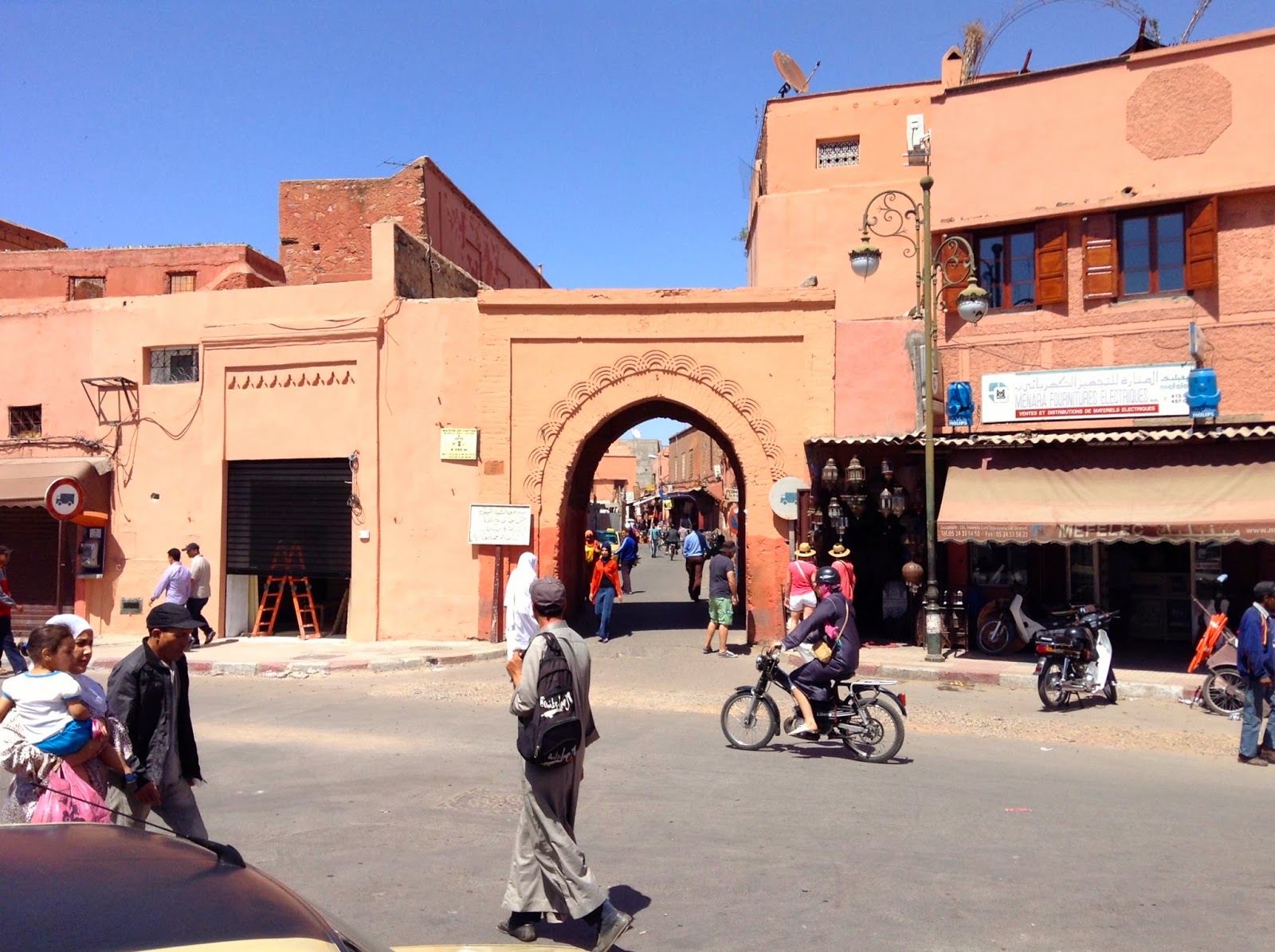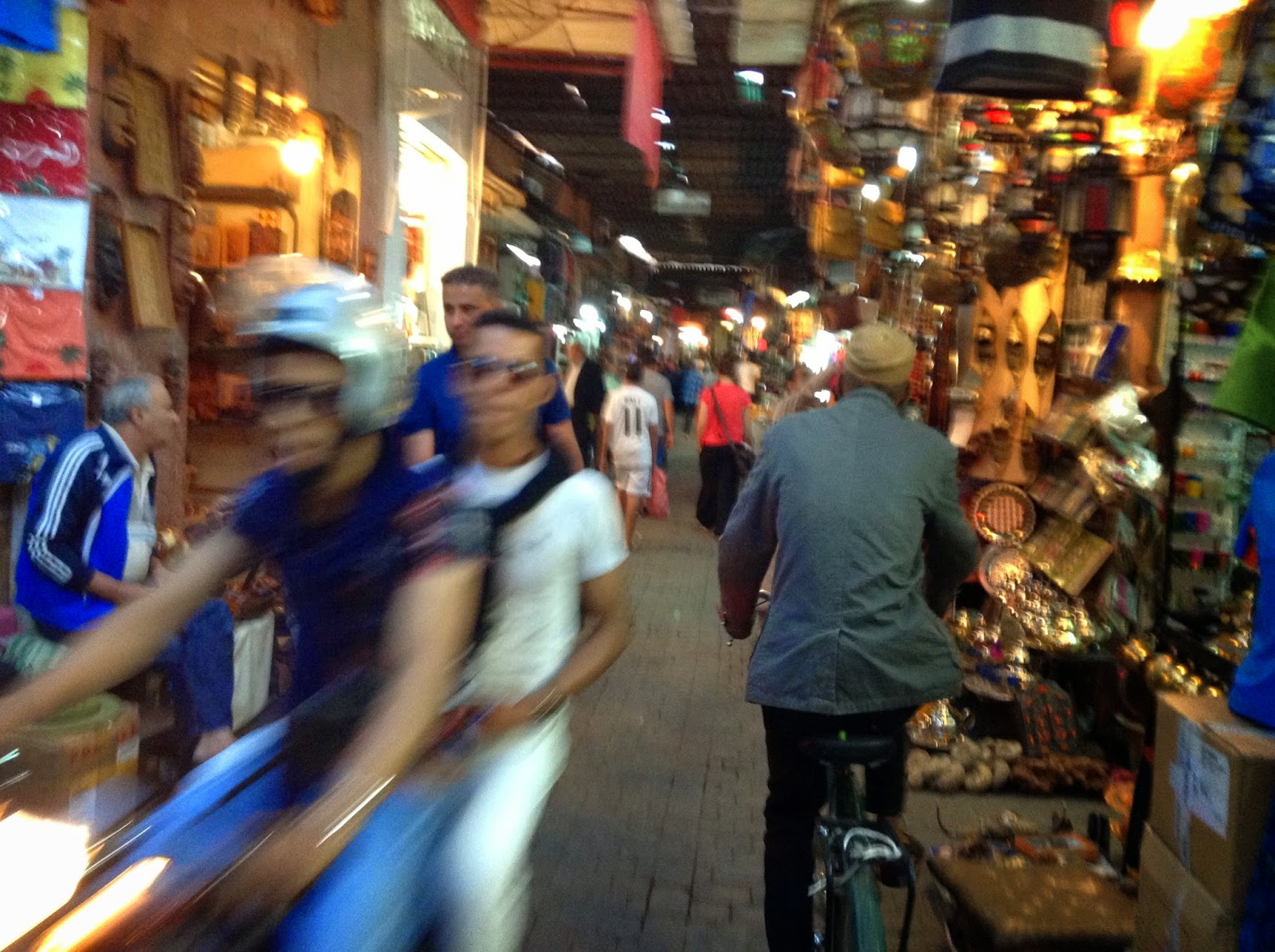I think if I had thought about it longer and harder, visiting Morocco would have freaked me out a little more than it did. I actually thought on the plane ride to Marrakech that this was way too adventurous for me and that I should have stuck with the United States and western Europe as my vacation stomping grounds. But by then, of course, it was way too late and there was no turning back. If there was one thing that gave me comfort on the trip south from Spain about how comfortable my time in Morocco would be, it was my choice of hotels. I knew I'd picked the right place to stay and that somehow it would provide essential insight to maximizing my experience in Morocco by helping me bridge the gap between the west and a country where everything seemed decidedly non-western to me. Turns out I was right.
Now when picking a place to stay on vacation, I'm usually a big hotel kind of guy; I tend to book rooms at large chain hotels, with a preference for American brands. I love the fact that I can be an anonymous face in a multi-story building in a big city and make the most of my experience on my own without anyone bothering me. I like figuring out my own way without any pressure and I think staying at a chain hotel lets me do that. It's sort of like my philosophy on my choice of schools: when deciding where to go to college, I deliberately picked large universities with a lot of students and tons of resources that wouldn't make me find my own way until I was ready to do it. That sort of choice doesn't work for everyone which I suppose is why bed and breakfasts exist in the hotel world. For the record, I have never stayed at a bed and breakfast.
But my three nights in Morocco turned out to be different. When researching where to stay in Marrakech, everything I read pointed towards staying in a riad as the most authentic Marrakech hotel experience. Riads are traditional inwardly focused courtyard residences which allowed privacy from the hustle and bustle of the center city. There are a ton of these riads within Marrakech's medina or old city which have been converted to hotels and the word was I had to stay in one or else risk missing a part of Marrakech. Once I was convinced that this form of hotel was the way to go, the hard part was choosing one. There are no Hilton or Holiday Inn operated riads; I would need to find a place on my own that I thought would be right for me. Scary. These kinds of decisions go well about half the time for me.
To make a selection go as smoothly as possible, I turned to Lonely Planet, which I consider the absolute best resource for travel advice when traveling outside of the United States; I never really consider buying any other sort of guidebook. Pages 74 through 78 of my Lonely Planet Morocco guide contained descriptions of a number of different places to stay, including about two dozen or more raids. But in reading through that book, one place stood out above all the rest: Riad l'Orangeraie, a riad pretty much right in the center of the medina on what looked like two major streets. The LP description of the place drew me in and my initial hunch about the place was confirmed by checking out their website and the websites of several other riads listed in Lonely Planet. I booked and hoped for the best.
 |
| The gate to the alley to Riad l'Orangeraie. |
One of the major draws to Riad l'Orangeraie for me was that if you wanted them to, they took care of everything, starting with a ride from the airport. When you arrive in a foreign country for the first time, you literally have no context of what anything costs so the exercise of getting a cab from the airport to your hotel is a pretty open ended proposition. You have no idea whether a ride will cost 50 dirhams (about $6) or 2,000 dirhams (about $250) and in a country where there are few meters in taxis and everything is negotiable, the open ended cost of getting into a cab gets worse. So we arranged for a car to pick us up, which cost 20 Euros (about $28) which I am sure was way more than we would have paid on our own, but our money got us not only a ride but an escorted walk down the alley to our hotel (the major street I had seen on a map was anything but that) by Aziz, our primary contact at the riad, who would serve as a source of a lot of information in the next three days.
When we finally arrived at the front door and crossed the threshold from the madness of the medina to inside the quiet of the riad's walls, we were greeted with mint tea and cookies and given the lay of the land, including a detailed map of the city, a tour of the riad and a cell phone for our use while we were in town along with instructions on how to call for help if we ever needed it. Riad l'Orangeraie is actually a double riad, two courtyard homes combined into a single property; it boasts seven guest rooms; a shared den; a rooftop terrace for relaxing and spying on the rest of the city from afar; and of course two courtyards, one of which featured a plunge pool for when the heat of the desert got to be too much. We never needed the cell phone, even when we got hopelessly lost in the nearby souks, but the reassurance that the device provided was worth it. It's a great touch.
 |
| The entrance courtyard... |
 |
| …and the plunge pool courtyard from above. |
The property itself is gorgeous. The walls of the riad do just what they are supposed to do and provide a safe haven from the city and the nearby souks. Outside the walls of the riad, there is the constant noise of voices shouting, motorcycles and donkeys; inside the walls there is nothing. Just silence. Until you get to the roof level and lean over the outside walls that is. Our room was tight but comfortable but the two courtyards and rooftop were so inviting that we spent most of our time in the riad in one of those two locations. It's honestly like having a little oasis where you are taken care of in this confusing but totally fascinating city. The room had air conditioning but we never used it, preferring the natural air coming in off the second courtyard of the property.
 |
| The rooftop terrace. The Ben Youssef Mosque is visible in the distance. |
More than anything, Riad l'Orangeraie offered what I had hoped: an authentic Marrakech experience. It is honestly right in the middle of everything and you can see the two most important mosques in Marrakech from the rooftop. We took a trip over the nearby Atlas Mountains (also arranged by the staff at the Riad) the second day we were in Marrakech and on the way out of town, we passed these huge hotels with finely manicured golf courses. If there's one thing I did not go to Morocco for, it's to play golf on sprinklered greens in a country with a perpetual water shortage. Notwithstanding the fact that I've never been anywhere to play golf, it's just not reality. You may as well go to Orlando or wherever else you can play golf. Doing it in Morocco is just not worth it.
In Morocco, I was visiting a place that was wonderful and strange and I wanted to experience all of it. For me that meant staying somewhere traditional and drinking in everything the city had to offer in the short time I was there, including being able to hear the azhan (call to prayer) from the various muezzins around the city. And believe me, you will hear it at Riad l'Orangeraie, especially the first at 3:45 am (not a typo). The first azhan is extra long because it includes a bonus line about prayer being better than sleep. At that time of the morning, I'm not buying it.
The staff at the Riad took care of us from the moment they met us at the car from the airport to the moment they put us back in a similar car. They allowed us to maximize our Moroccan experience. The service they offered was impeccable, from the laundry service to drinks and food on request to advice about where to go and what to do. The meal we had there on our first night was the best meal we had on our trip with the exception of one tapas experience in Madrid; the eggplant that their chef Nadia cooked was the best tasting eggplant I have ever had. The breakfasts that are included with the room were also the best breakfasts I have had maybe in my life. I never knew plain yogurt could taste so good.
 |
| Best breakfast ever!!!! |
If I ever go back to Marrakech, I'm staying at Riad l'Orangeraie without question. I can't imagine any place taking better care of me or having a better location. They really have created a unique and genuine (such as I understand it) experience in Morocco. No doubt there are probably cheaper places to stay but considering the price point (140 Euros or about $200 per night) I wouldn't consider trying somewhere else to save a couple of bucks. There's no way Morocco would have been the same staying somewhere else.
No place is perfect and I wouldn't be offering an honest assessment without a couple of words of caution. The bed in our room was not the most comfortable I have slept in. This wouldn't change my choice of hotels. Nor would the shower instructions (below), which encourage you to conserve water since it's so precious in the desert climate. It's the first time I've ever turned the shower on then off, lathered up with soap, and then rinsed off. I sort of felt better about myself for doing this and the orange scented glycerine soap makes up for the lack of a traditional shower experience. I know I've used this word several times but this place offers an authentic experience that I can't imagine can be beat. Go to Marrakech and stay here!










